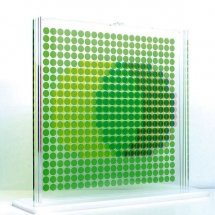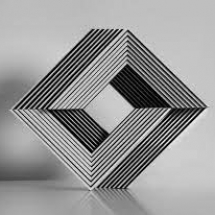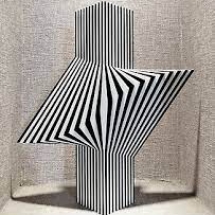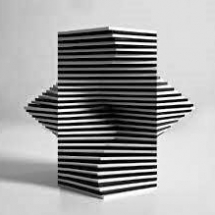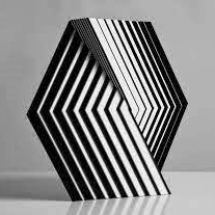Luisa Russo
Biography
Luisa Russo è nata a Napoli nel 1976 e qui vive e lavora. Si diploma prima all’Istituto d’Arte, poi all’Istituto Superiore di Design di Napoli, da subito comincia l’attività di graphic designer. Il passaggio all’arte avviene un decennio dopo. Fin dagli albori della sua ricerca, si è interessata alle dinamiche costruttiviste, nel tentativo di esplorare nuove possibilità creative, sia negli aspetti formali che in quelli tecnici, operativi, speculativi, di materiale e di contenuto, in cui il legame tra “arte e tecnologia”, o “arte e scienza”, è sempre un rapporto difficile da decifrare. Pur cercando di portare avanti una ricerca che non sia solo una sorta di gioco ottico-visivo, dove le dinamiche della costruzione dell’opera suscitano una razionale partecipazione emotiva dello spettatore, l’opera è “forma” che si fa “struttura” – “contenuto e contenitore”: il loro funzionamento conduce a un processo di trasformazione che non porta necessariamente al “diverso”, ma alle mutazioni dell’opera in relazione alla percezione di essa, anche oltre il suo spazio, lo spazio che occupa e lo spazio che rimane fuori dalla portata della percezione dello stesso spettatore.
ESPOSIZIONI
ESPOSIZIONI
2022
- EXPOSITIE 78 – GEOMETRISCHE PROCESSEN – GALERIE CONNY VAN KASTEEL – AMSTERDAM
- UN VOLUME D’ARTE – SPAZIO VITALE – AVERSA
- ANALIZZIAMO GRUPPO C.O.N.V.I.D. – NOALE – VERONA
- CINETIQUE II – BRATISLAVA
- TRIPERSONALE – MULTIVERSO GEOMETRIA ENERGIZZANTE -SPAZIO VITALE – AVERSA
- AREALITEES NOUVELLES – SPAZIO VITALE – AVERSA
- ANALISI PERCETTIVA GRUPPO C.O.N.V.I.D. – SALA PESCHERIA – PADOVA
- CINETIQUE II – PRAGA
- DOMNA – QUARTIERE MILITARE BORBONICO CASAGIOVE
2021
- STATI D’ARTE – MOSTRA INTERNAZIONALE D’ARTE CONTEMPORANEA – DALLAS TEXAS
- ORIGIN IN GEOMETRY – BIENNIAL 2021 – NOTO SICILIA
2020
- GALLERIA PALAZZO NICOLACCI – NOTO SICILIA
- CINÉTIQUE II – HÀROM HÈT GALÈRIA – BUDAPEST
- CINÉTIQUE II – MUSEO LAPIDARIUM – CROAZIA
2019
- CINÉTIQUE II – GALERIE RENATE KAMMER – HAMBURGO GERMANIA
- CINÉTIQUE II ESPACE FANAL – BASILEA SVIZZERA
- CINÉTIQUE II – GALERIE ABSTRACT PROJECT – PARIGI FRANCIA
- ARTE GENOVA – GENOVA ITALIA
2018
- FREEZONE – AM STUDIO – ART GALLERY -NAPOLI ITALIA
2017
- ASTRATTISTI GEOMETRICI A CONFRONTO – ISTITUTO DI STUDI SULL’ASTRATTISMO E L’ANICONISMO – SALERNO ITALIA
2016
- NAPOLI EXPÒ ART POLIS PALAZZO DELLE ARTI – NAPOLI ITALIA
- ART PERFORMING FESTIVAL CASTEL DELL’OVO – NAPOLI ITALIA
2015
- ARTE PADOVA – PADOVA ITALIA
- NAPOLI EXPÒ ART POLIS PALAZZO DELLE ARTI – NAPOLI ITALIA
- ART PERFORMING FESTIVAL CASTEL DELL’OVO – NAPOLI ITALIA
- ARTE PADOVA – PADOVA ITALIA
- NAPOLI EXPÒ ART POLIS PALAZZO DELLE ARTI – NAPOLI ITALIA
Texts of Critics
Shape turning into structure
Saverio Cecere
Luisa Russo is a young artist who, since early start of her research, was interested first in graphic design and then in constructive dynamics, trying to explore new creative options in formal aspects as well as in technical, operational, speculative ones, in materials and contents, where the bond between art and technology, or art and science, is always a difficult one to decipher.
As to the “legitimacy” of new tools used in art and creativity, the artist brings light with her surprising identity: observing, analysing, building up a hypothesis. In other words, she knows how to create links between “idea” and “creating an idea” in relation to materials, technologies and information available, where “geometry and human” and “idea and poetry” come in relation together and complement each other.
Starting from the assumption that in the real world nothing is defined or definable, her research represents the rationalist spirit which, starting from basic principles, intuitively or experimentally identifiable such as the axioms of Geometry or the principles of Mechanics and Physics, tries through a deductive process to be able to develop new problems and to find new aesthetic solutions where nothing is left to the randomness of improvisation. Even the irrationality is guided by the compactness of the “shape”, so that even the substance making the artwork becomes conscious stratification of different moods: in this way in Luisa Russo’s artworks one can observe the miracle of the pacific coexistence between the “motives of the heart” and the “motives of the intelligence”, in accordance with the author’s unexposed faith in the consistency between aesthetic and ethic conscience.
In her scientific similarities and correspondences, her work is for her on the verge of not only the phenomenon world, but also of an approach to research based on and explained through its features and its constructive elements.
Despite trying to carry forward a research that is not only a sort of optic-visual game, where the dynamics of creating the artwork bring up a rational emotional participation of the viewer, Luisa’s work is “shape” turning into “structure” – “content and container”: their functioning leads to a process of transformation which doesn’t necessarily lead to the “diverse”, but to the mutation of the work with respect to the perception of it, also beyond its space, the space occupied by it and the space that remains beyond the viewer’s perception capabilities.
In her work one can see
The formal perfection, the shape
The inspiring thought, the content
The power, aesthetic value
The beauty, corresponding to the true and to the world of the ideas in Aristotle’s terms.
We could say that the research brought forward by the artist is a flow that goes directly from the artwork to the viewer, where the artwork’s emotional power projects itself in those who look at it and touches them emotionally. On the contrary, the expressive value, or structure, goes from the viewer to the artwork: “I observe a painting and am able to appreciate it: thanks to my sense of aesthetics and to my knowledge I decipher it and can understand “what’s behind it”. Visible out of the invisible. Shape is the skeleton of the artwork, content is its brain;
The expressive value or structure is the beauty of the face and of the body, the aesthetic value is the heart.
LUISA RUSSO
Barbara Bortot
L’arte di Luisa Russo è comunicazione e alto intrattenimento. Ripercorrere il suo operato artistico, di grande impatto visivo, richiama numerosi affascinanti parallelismi con il mondo del cinema (come l’avventura futurista), della televisione, della pubblicità. Mi ha in particolare evocato dei fondali di Mario Ceroli, alcuni Caroselli e scenografie degli anni ’60 ’70, i sapienti controluce ad esempio degli short del regista pubblicitario Enrico Sannia, le grafiche della storica sigla RAI che dal 1954 al 1985 annunciava l’inizio e chiusura trasmissioni, il piccolo logo di Pura Lana Vergine disegnato dall’artista Franco Grignani e altri famosi marchi aziendali (Givency, Renault, …). Certamente le sperimentazioni di Luisa Russo risentono della sua formazione. I tecnicismi della grafica e del design, però, vengono caricati di una componente quasi magica, che libera la forma. L’artista napoletana realizza opere multiformi, la cui sostanza fondante è proprio il pensare di non avere limiti e la cifra stilistica i bianco e nero. In una prima fase sono più geometriche, caratterizzate da una divisione di zone di luce e ombre ottenuta principalmente attraverso l’ortogonalità. In seguito abbiamo soluzioni che apparentemente sembrano quelle di Castellani. Apparentemente. Luisa infatti destruttura completamente le regole acquisite; le vuole rompere con l’obiettivo di togliere
“peso visivo” per andare verso opere più fluttuanti. Il creare ritmiche estroflessioni come un gioco di ripetizioni e combinazioni di pieni e vuoti o come tormentato dominio sulla materia per far scorrere la luce con esiti espressivi moderni non le interessa. Ciò che l’intriga e avvince totalmente è “portare” i concetti di levità e di trasparenza. Da questa prospettiva vanno visti i lavori in cui prevale la ricerca della curva anzichè degli angoli, le lavorazioni smaterializzate di lastre in plexiglass e le più recenti estroflessioni, costituite da tre fogli sovrapposti, di toni man mano più chiari (una sorta di passaggi tonali per sottrazione). Nella libera riscrittura della spazialità quale il successivo percorso espressivo di Luisa Russo? Come in attesa della prossima puntata del programma preferito o di una serie che mi ha catturato, sono curiosa di vedere dove la sua sempre nuova e ardita vitalità la porterà, oltre a quali sviluppi artistici si spingerà.
MODULAZIONI GEOMETRICHE
Stefania Gaudiosi
Luisa Russo’s work is deeply rooted in the experiences lived during her artistic and professional training in the field of graphics. It is founded, in fact, on a strict working method, skills in governing the abstract form and the linguistic elements that compose it.
The methodological procedure is, at the same time, a clear homage to Op Art (Optical Art), an artistic trend of secular extent that aimed to the completion of a completely new language, and an original reinterpretation of the classic themes of abstract art.
In her work there is approximated by gradual steps,
through visual exercises that arise in
tight connection with the work of the great masters who in the sixties began the current made of pure visuality and its inherently complex nature of the nucleus of an activity forming revolutionary, yet completely contemporary.
it is a methodology that suggests his virtuous evolution.
Luisa Russo’s experiments collect the more abstract and rigorous aspect of the work on the form and are placed symbolically in this area of contemporary artistic creation. Just as the music is a lyrical changes rich in meaning, the same way her work is devoid of any narrative value or functional or representative. It is the form in
mysterious purity that is sufficient unto itself.
Each of the exhibits is a variant, articulation, modulation, an expressive possibility based on a precise compositional rule, a clear genetic blueprint and
essential, often accentuated by the alternating rhythm of white and black.
Because art has always been the mirror of a higher realm that is only given to us,
significantly, a swift touch.


